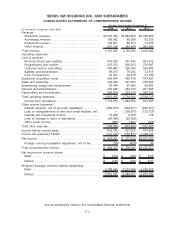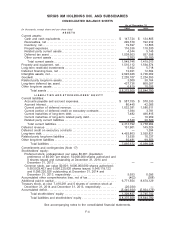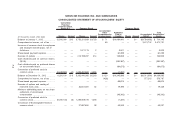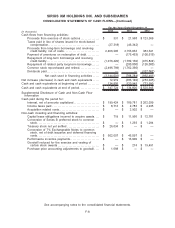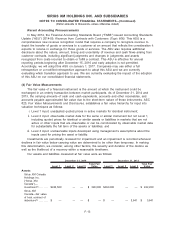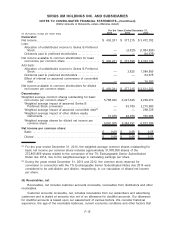XM Radio 2014 Annual Report Download - page 119
Download and view the complete annual report
Please find page 119 of the 2014 XM Radio annual report below. You can navigate through the pages in the report by either clicking on the pages listed below, or by using the keyword search tool below to find specific information within the annual report.
Recent Accounting Pronouncements
In May 2014, the Financial Accounting Standards Board (“FASB”) issued Accounting Standards
Update (“ASU”) 2014-09, Revenue from Contracts with Customers (Topic 606). This ASU is a
comprehensive new revenue recognition model that requires a company to recognize revenue to
depict the transfer of goods or services to a customer at an amount that reflects the consideration it
expects to receive in exchange for those goods or services. The ASU also requires additional
disclosure about the nature, amount, timing and uncertainty of revenue and cash flows arising from
customer contracts, including significant judgments and changes in judgments and assets
recognized from costs incurred to obtain or fulfill a contract. This ASU is effective for annual
reporting periods beginning after December 15, 2016 and early adoption is not permitted.
Accordingly, we will adopt this ASU on January 1, 2017. Companies may use either a full
retrospective or a modified retrospective approach to adopt this ASU and we are currently
evaluating which transition approach to use. We are currently evaluating the impact of the adoption
of this ASU on our consolidated financial statements.
(4) Fair Value Measurements
The fair value of a financial instrument is the amount at which the instrument could be
exchanged in an orderly transaction between market participants. As of December 31, 2014 and
2013, the carrying amounts of cash and cash equivalents, accounts and other receivables, and
accounts payable approximated fair value due to the short-term nature of these instruments. ASC
820, Fair Value Measurements and Disclosures, establishes a fair value hierarchy for input into
valuation techniques as follows:
i. Level 1 input: unadjusted quoted prices in active markets for identical instrument;
ii. Level 2 input: observable market data for the same or similar instrument but not Level 1,
including quoted prices for identical or similar assets or liabilities in markets that are not
active or other inputs that are observable or can be corroborated by observable market data
for substantially the full term of the assets or liabilities; and
iii. Level 3 input: unobservable inputs developed using management’s assumptions about the
inputs used for pricing the asset or liability.
Investments are periodically reviewed for impairment and an impairment is recorded whenever
declines in fair value below carrying value are determined to be other than temporary. In making
this determination, we consider, among other factors, the severity and duration of the decline as
well as the likelihood of a recovery within a reasonable timeframe.
Our assets and liabilities measured at fair value were as follows:
Level 1 Level 2 Level 3
Total Fair
Value Level 1 Level 2 Level 3
Total Fair
Value
December 31, 2014 December 31, 2013
Assets:
Sirius XM Canada
Holdings Inc.
(“Sirius XM
Canada”)—
investment(a). . . . . . . . $246,500 — — $ 246,500 $432,200 — — $ 432,200
Sirius XM
Canada—fair value
of host contract of
debenture(b) . . . . . . . . $ — — — $ — $ — — 3,641 $ 3,641
F-13
SIRIUS XM HOLDINGS INC. AND SUBSIDIARIES
NOTES TO CONSOLIDATED FINANCIAL STATEMENTS—(Continued)
(Dollar amounts in thousands, unless otherwise stated)


